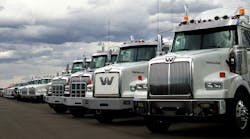The debate over Mexican trucks on U.S. highways is sure to intensify over the coming months following the “concept document” the U.S. DOT unveiled yesterday. What is also likely to continue is the flawed argument by opponents of the program that allowing these trucks on U.S. roadways increases the risks to Americans.
(The Dept. of Transportation has posted the proposal on its website. You can find it here.)
Todd Spencer, executive vice president of the Owner-Operator Independent Drivers Assn. (OOIDA), echoed those same thoughts.
“While we appreciate that the administration is proposing to allow Congress and the public to weigh in on a future trucking program with Mexico, they seem to be missing the main issue at hand. The onus is upon Mexico to raise their regulatory standards, not on the U.S. to lower ours to accommodate their trucking industry.”
The problem with these arguments – and we’ll hear plenty more along the same lines, many coming from politicians themselves – is that the process as it’s proposed (and it still has go to through both negotiations with Mexican officials and a public comment period that DOT said it will allow) would require any Mexican truck to meet U.S. EPA emissions standards and Federal Motor Vehicle Safety Standards.
The same standards that all U.S. carriers must meet. If Mexican trucks can meet those standards, how can the argument be that those vehicles are unsafe? Unless, of course, we’re saying that DOT is not allowing safe vehicles on our roadways. Is that what we’re really arguing?
And Mexican drivers, too, would have to meet certain standards. They would have to be drug-tested, meet minimum English proficiency standards, be vetted by both the Dept. of Justice and Dept. of Homeland Security, and demonstrate through testing that they have acceptable knowledge of U.S. traffic laws.
Heck, there are a whole lot of Americans driving today that don’t know U.S. traffic laws.
Hoffa also raises the point of personal safety, given Mexico’s trouble with the drug cartels.
“Given the drug violence, there’s no way a U.S. company would want to haul valuable goods into the Mexican interior,” Hoffa said. “Trade agreements are supposed to benefit both parties, but this is a one-way street.”
No, the real argument against Mexican trucks has nothing to do with safety; it has to do with jobs. Opponents are concerned that allowing Mexican trucks to operate within the U.S. borders will cost truck drivers their jobs.
“With so much focus in Washington on creating jobs, it’s a bit shocking that the administration would pursue a program that can only rob U.S. drivers of their jobs,” said Spencer.
Might it? Probably some, I’ll admit that. But I don’t think it will cost anywhere near the number of jobs people believe. In fact, if the final program is similar to the agreement between the U.S. and Canada, Mexican drivers will be able to make a delivery and then a pickup and head right back to Mexico with no additional stops.
In the end, there really is no choice. We have to have a cross-border program of some sort under the terms of NAFTA. We might as well make the best of it.
I hope, though, that we argue the merits of this proposal on the real facts and not cloud decision-makers’ minds with fear tactics over “dangerous” trucks.




